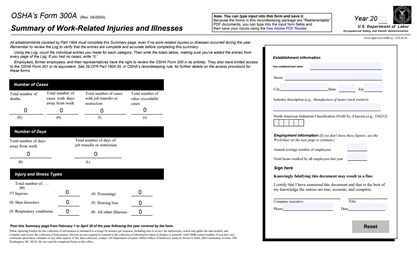Find out what you need to do
Each year OSHA requires most employers to comply with an annual posting requirement, and certain larger employers, or those in certain industries, to report workplace injuries from the previous year. In 2024, OSHA mandates new electronic reporting requirements for larger employers to enhance workplace safety oversight. Here's a concise breakdown of what employers need to know:
 |
Posting Requirements
Who Must Post: Employers with more than 10 employees, except those in exempt industries, are required to track and post a summary of workplace injuries and illnesses using OSHA Form 300A from February through April each year. The posting must be made in a visible location so that your employees are aware of the injuries and illnesses that occurred the previous year in the workplace.
Electronic Submission Requirements
Who Must Comply: Covered employers with 250+ employees (100+ employees in certain high-hazard industries) must electronically submit information from the OSHA 300 Log of Workplace Related Injuries/Illness, the 300A Summary of Injury/Illness, and 301 Accident and Injury Report online.
Covered employers with as few as 20 employees are required to electronically submit information from Form 300A (as opposed to information from all forms) if they are in a designated high-risk industry.
See table below.
|
Who |
Forms to Be Submitted |
Must be Submitted |
|
Employers with 20+ employees in high-risk industries |
March 2, 2024 |
|
|
Employers with 100 – 249 employees in high-risk industries |
March 2, 2024 |
|
|
Employers with 250+ employees |
March 2, 2024 |
Scope: This applies to businesses under Federal OSHA and those in states with approved occupational safety programs (State Plans).
Submission Methods: Data can be submitted through OSHA's Injury Tracking Application (ITA) via web form, CSV file, or API feed.
Deadline: The annual submission deadline is March 2, for the previous year's data.
What Types of Injuries/Illnesses Need to Be Recorded?
OSHA considers an injury or illness to meet the general recording criteria, and therefore to be recordable, if it results in any of the following:
You must also consider a case to meet the general recording criteria if it involves a significant injury or illness diagnosed by a physician or other licensed healthcare professional, even if it does not result in any of the above.
Key Takeaways
These updated regulations streamline reporting and reinforce the importance of workplace safety and compliance. Employers should ensure timely submission of electronic records and adherence to posting summaries to avoid penalties and contribute to a safer working environment. Also, do not forget, all employers, including those partially exempted because of company size or industry classification, must always report to OSHA any workplace incident that results in a fatality or the hospitalization of three or more employees.